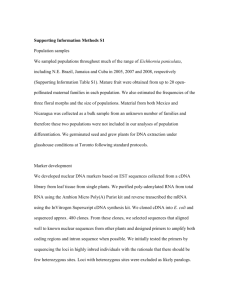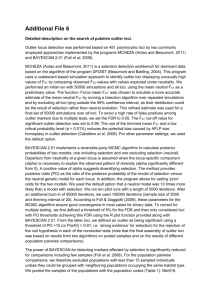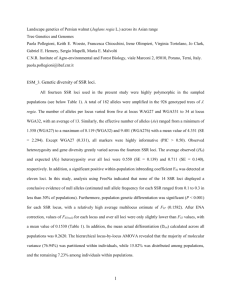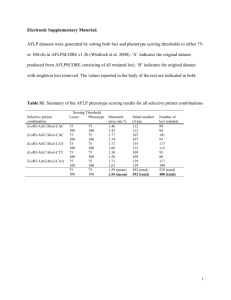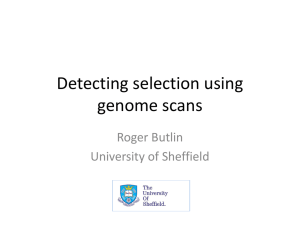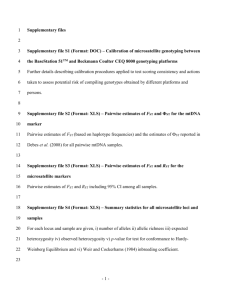Text S1 - SUPPORTING INFORMATION Three decades of farmed
advertisement
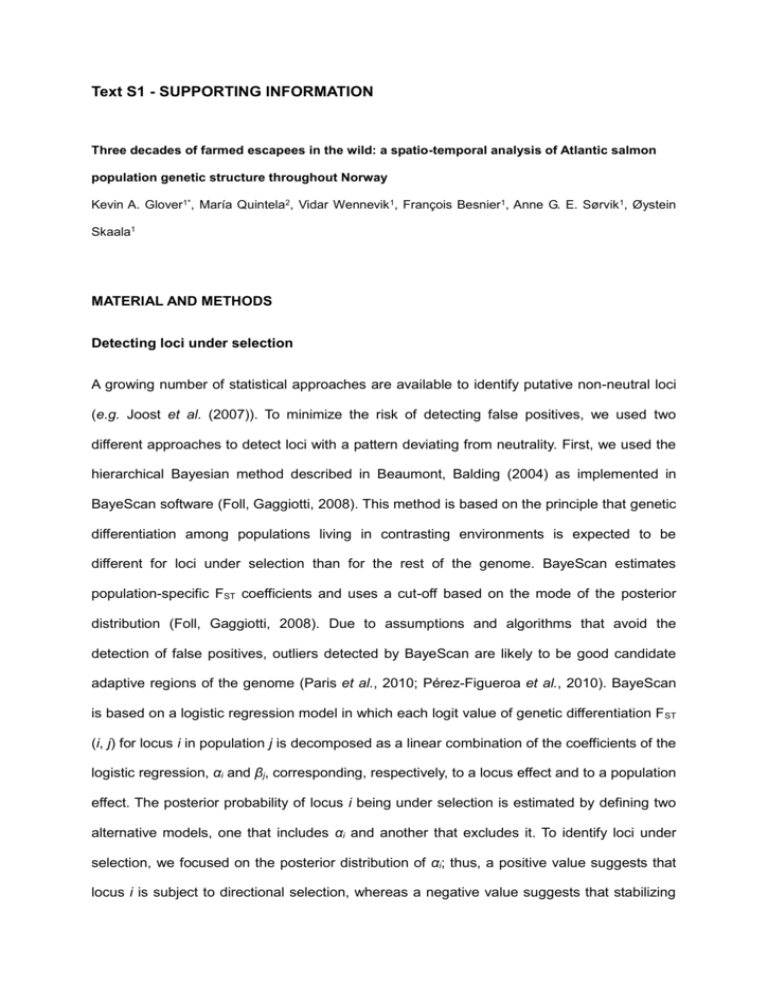
Text S1 - SUPPORTING INFORMATION Three decades of farmed escapees in the wild: a spatio-temporal analysis of Atlantic salmon population genetic structure throughout Norway Kevin A. Glover1*, María Quintela2, Vidar Wennevik1, François Besnier1, Anne G. E. Sørvik1, Øystein Skaala1 MATERIAL AND METHODS Detecting loci under selection A growing number of statistical approaches are available to identify putative non-neutral loci (e.g. Joost et al. (2007)). To minimize the risk of detecting false positives, we used two different approaches to detect loci with a pattern deviating from neutrality. First, we used the hierarchical Bayesian method described in Beaumont, Balding (2004) as implemented in BayeScan software (Foll, Gaggiotti, 2008). This method is based on the principle that genetic differentiation among populations living in contrasting environments is expected to be different for loci under selection than for the rest of the genome. BayeScan estimates population-specific FST coefficients and uses a cut-off based on the mode of the posterior distribution (Foll, Gaggiotti, 2008). Due to assumptions and algorithms that avoid the detection of false positives, outliers detected by BayeScan are likely to be good candidate adaptive regions of the genome (Paris et al., 2010; Pérez-Figueroa et al., 2010). BayeScan is based on a logistic regression model in which each logit value of genetic differentiation F ST (i, j) for locus i in population j is decomposed as a linear combination of the coefficients of the logistic regression, αi and βj, corresponding, respectively, to a locus effect and to a population effect. The posterior probability of locus i being under selection is estimated by defining two alternative models, one that includes αi and another that excludes it. To identify loci under selection, we focused on the posterior distribution of αi; thus, a positive value suggests that locus i is subject to directional selection, whereas a negative value suggests that stabilizing selection is tending to homogenize allele frequencies over the populations. The respective posterior probabilities of these two models are estimated using a reversible jump Markov chain Monte Carlo (RJMCMC) approach. The posterior probability that a locus is subjected to selection (P (αi ≠ 0)), is then estimated from the output of the RJMCMC by counting the number of times αi is included in the model. The estimation of model parameters was automatically tuned on the basis of short pilot runs (10 pilot runs, length 10000, burn in 100000). The sample size was set to 10000 and the thinning interval to 50 as suggested by Foll and Gaggiotti (2008), resulting in a total chain length of 600000 iterations. The Bayes factor (BF) criteria defined by Jeffreys (1961) as the ratio of the probabilities of the data under alternative hypotheses (selection vs. no selection) was used to consider a locus under selection. Loci were ranked according to their estimated posterior probability and those with a posterior probability over 0.99, were retained as outliers, which corresponds to a Bayes Factor >2 (i.e. “decisive selection” (Foll, Gaggiotti, 2006)) and provides substantial support for accepting the model. Secondly, we used the Beaumont, Nichols (1996) Fdist approach, implemented in LOSITAN (Antao et al., 2008) selection detection workbench for codominant markers. LOSITAN uses coalescent simulations to generate a null distribution of FST values based on an infinite island model for the populations and an infinite allele model or a stepwise mutation model for polymorphism. Loci with an unusually high FST are putatively under directional selection, while loci with low FST value are considered to be potentially under stabilizing selection. In this study, we simulated the neutral distribution of FST with 1000000 iterations at a significance P value of 0.005. Runs were performed using the two possible mutation models: the stepwise mutation model and the infinite allele model. This method also implements a multitest correction based on false discovery rates (FDR) that is fundamental to avoid high overestimation of the percentage of outliers (e.g. 1% of false positive with a threshold of 99%). RESULTS When combining the results obtained from both analytical approaches (Table A1, Table A2) we found that samples corresponding to the historic data set showed three loci under directional selection and five under stabilizing selection whereas the contemporary data set showed the same loci under directional selection but only two of the former ones under stabilizing selection. Interestingly, loci SSsp2216, Ssa197, and SsaD144 that had been depicted under stabilizing selection in the historic data set became neutrals in the contemporary samples. The neutral data set was, therefore, built after excluding the eight loci that showed patterns deviating from neutrality; i.e. MHC2, SsaF43, Ssa289, SSsp2216, Ssa197, SsaD157, SsaD144, SSsp2201. REFERENCES Antao T, Lopes A, Lopes R, Beja-Pereira A, Luikart G (2008) LOSITAN: A workbench to detect molecular adaptation based on a FST-outlier method. BMC Bioinformatics 9, 323. Beaumont M, Nichols R (1996) Evaluating loci for use in the genetic analysis of population structure. Proceedings: Biological Sciences 263, 1619-1626. Beaumont MA, Balding DJ (2004) Identifying adaptive genetic divergence among populations from genome scans. Molecular Ecology 13, 969-980. Foll M, Beaumont MA, Gaggiotti O (2008) An approximate Bayesian computation approach to overcome biases that arise when using Amplified Fragment Length Polymorphism markers to study population structure. Genetics 179, 927-939. Foll M, Gaggiotti O (2006) Identifying the environmental factors that determine the genetic structure of populations. Genetics 174, 875-891. Foll M, Gaggiotti O (2008) A genome-scan method to identify selected loci appropriate for both dominant and codominant markers: A Bayesian perspective. Genetics 180, 977-993. Jeffreys H (1961) Theory of Probability, 3rd edn. Clarendon Press, Oxford, UK. Joost S, Bonin A-, Bruford MW, et al. (2007) A spatial analysis method (SAM) to detect candidate loci for selection: towards a landscape genomics approach to adaptation. Molecular Ecology 16, 3955-3969. Paris M, Boyer S, Bonin A, et al. (2010) Genome scan in the mosquito Aedes rusticus: population structure and detection of positive selection after insecticide treatment. Molecular Ecology 19, 325-337. Pérez-Figueroa A, García-Pereira MJ, Saura M, Rolán-Álvarez E, Caballero A (2010) Comparing three different methods to detect selective loci using dominant markers. Journal of Evolutionary Biology 23, 2267-2276. Table A1.- Historic samples.- Shaded cells with numbers in bold depict loci detected to be under selection by: BayeScan (log10(BF)>2 corresponding to “decisive selection”) and LOSITAN at a significance P value of 0.01 under the stepwise and infinite alleles mutation models. Note that locus SsaF43 with log10(BF)=1.79 is above the threshold of “very strong selection” LOSITAN Locus Stepwise P (Simul FST <sample FST) Infinite alleles P (Simul FST <sample FST) BayeScan log10(BF) FST Selection MHC2 0.9997 0.9994 1000 0.07074 SsaF43 0.9995 0.9998 1.7944 0.065242 Directional Ssa289 0.9947 0.9985 2.8232 0.071331 Directional SSsp2216 0.0004 Ssa197 0.0060 0.0000 2.1216 0.020748 Stabilizing 0.0000 2.2902 0.020304 Stabilizing SsaD157 0.0042 0.0000 2.2988 0.020314 Stabilizing SsaD144 0.0176 0.0000 3.5227 0.017856 Stabilizing SSsp2201 0.0160 0.0000 1000 0.015246 Stabilizing Directional Table A2.- Contemporary samples.- Shaded cells with numbers in bold depict loci detected to be under selection by: BayeScan (log10(BF)>2 corresponding to “decisive selection”) and LOSITAN at a significance P value of 0.01 under the stepwise and infinite alleles mutation models. LOSITAN Locus Stepwise P (Simul FST <sample FST) Infinite alleles P (Simul FST <sample FST) BayeScan log10(BF) FST Selection MHC2 0.9999 1.0000 3.9999 0.048866 Directional Ssa289 0.9968 0.9894 3.0965 0.050822 Directional SsaF43 0.9998 1.0000 0.84465 0.041503 Directional SsaD157 0.0186 0.0002 3.6988 0.011784 Stabilizing SSsp2201 0.0211 0.0000 2.35459 0.013147 Stabilizing
